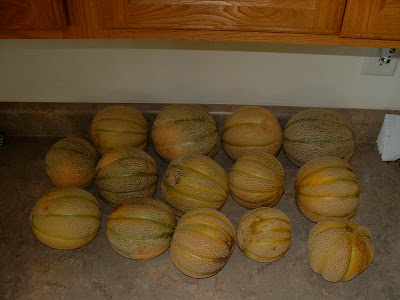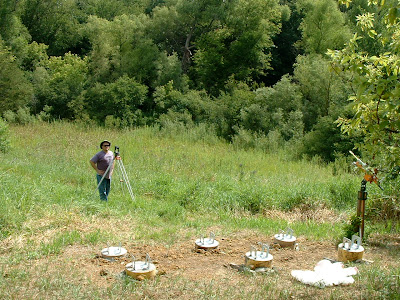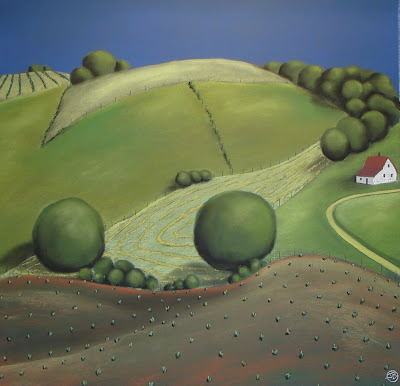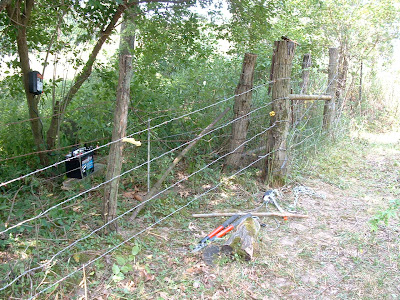We have all we need for everyone to live well.
Tuesday, July 31, 2012
Monday, July 30, 2012
Maiden Voyage
If it looks like we're having fun around here it's because we are. Don't get me wrong there has been plenty of hard work along the way and I have the bum shoulders to prove it. Sometimes though we really let our hair down.
This was the first time Alan has been able to use his dad's old Evinrude Lightwin motor since it was tuned up a few years ago. My brother, David, has graciously given us his old beloved BassTender. It is a tiny little thing that is only rated to up to 6 hp and hasn't seen water in a long while. The Ace hose cap seemed to work and there was just a 1/2 cup of water in the stern when we finished playing around for the evening.
Alan said he thought we'd reached a new "white trash" limit but that was before we actually got the vessel out on the pond. I think it is pretty awesome and the "necks" would think it much to sophisticated. We keep talking about putting a motor mount on the dock. Now that would be "White Trash" but damn it'd be funny. Don't worry we'll take video.
This was the first time Alan has been able to use his dad's old Evinrude Lightwin motor since it was tuned up a few years ago. My brother, David, has graciously given us his old beloved BassTender. It is a tiny little thing that is only rated to up to 6 hp and hasn't seen water in a long while. The Ace hose cap seemed to work and there was just a 1/2 cup of water in the stern when we finished playing around for the evening.
Alan said he thought we'd reached a new "white trash" limit but that was before we actually got the vessel out on the pond. I think it is pretty awesome and the "necks" would think it much to sophisticated. We keep talking about putting a motor mount on the dock. Now that would be "White Trash" but damn it'd be funny. Don't worry we'll take video.
Sunday, July 29, 2012
Rainbow at Dawn
We set a live-capture trap for whatever it is that's scaling the fence and eating the sweet corn, using cat food for bait on the assumption that we're dealing with raccoons. Temperatures cooled enough overnight that about four o'clock this morning I turned off the air conditioning and opened the windows and listened to the breeze in the sycamore, the bullfrogs in the pond, and a few errant drops of rain upon the roof. By five-thirty I'd had enough bed time and got up to find that the trap hadn't caught anything, but neither were there any freshly-molested corn stalks.
Eye Chair exposed! It had been buried beneath a fallen, over-mature black cherry.
That black cherry is now a stack of logs. We're looking into ways we might market the wood, possibly as stock for lathe turners, lumber for furniture or flooring, or gunstock blanks.
Here a trail branches into a loop through Cedar Grove. Counting the field perimeters I think we've got about three miles of trail at this point, with a wonderful variety of vantages, up and down hills, along the creek, past the old growth giants.
Just at sunrise this was the view to the east.
And to the west, a symbol of hope. A little later a nice shower fell but I don't think it amounted even to a tenth of an inch.
We're finalizing preparations for a to-do that commences in a few days, the Palmer Long Outdoor Weekend, Muscatine Edition. The working-out of the acronym is left as an exercise for the reader.
We're keen to get the trails in good shape, so Alan and I were out with the chainsaw and rotary brush mower, pushing through the spots where fallen trees obstructed the old tractor trails that we're re-establishing, and finishing the surfaces.
Eye Chair exposed! It had been buried beneath a fallen, over-mature black cherry.
That black cherry is now a stack of logs. We're looking into ways we might market the wood, possibly as stock for lathe turners, lumber for furniture or flooring, or gunstock blanks.
Here a trail branches into a loop through Cedar Grove. Counting the field perimeters I think we've got about three miles of trail at this point, with a wonderful variety of vantages, up and down hills, along the creek, past the old growth giants.
And we've essentially completed the shooting platform at the trap range. It is a very sturdy construction!
We've got some other features in store for our guests this weekend, and those that follow. But that is all for today!
Friday, July 27, 2012
Drought and Despite
Temperatures have moderated a little the past couple days – 80s and 90s, but the drought is relentless and there is no rain in the forecast. The survival of plant life depends on the amount of water in the soil column that can be extracted in the root zone, and evapotranspirative demand by the plant. The following chart indicates ET at several stations in the state, calculated with Penman's equation and using a crop coefficient of 1, simulating conditions for well-watered turf. The coefficient and thus ET becomes lower with exposed soil and with water in the root zone at less than field capacity (the amount of water the soil will hold just before it begins to drain).
The chart shows an ET value of 0.28 inches at the Muscatine station yesterday, in line with what have been daily values of 0.25-0.33 inches for the past several weeks. Depending on soil composition (relative proportions of sand, silt, clay, humus) and structure (for instance, the size, shape, and number of voids), a foot of soil might hold 1-4 inches of water at field capacity. Depending on the crop, the root zone might be 1-4 feet. The issue with drought in rainfall-dependent areas becomes obvious.
The garden is stressed. The sweet corn and popcorn have some leaf curl but seems to be slowly filling the ears. But some critters larger than rabbits, probably raccoons, are scaling the fence now, breaking down the stalks and leaving half-eaten ears on the ground. I see electric fencing in our future.
A few individual fruits in the Concord grape clusters are beginning to show some purple. These are old vines with a well-established root structure, so we'll probably have a harvest and then another method of preservation to learn – jelly!
The cucurbits (the plant family that includes squashes, melons, and cucumbers) wilt alarmingly in the heat of the day but recover again in the evening, and so far are bearing prolifically. The winter squash are filling, and the melon are ready to eat and are delicious. Today I cleared the cucumber vines of all the overripe fruit. They're still blossoming profusely and now we can try again to harvest them while they're still pickle-sized. Our attempts at pickling the first batch of overripe fruit have been a mixed bag as the skins of some were just too bitter for the vinegar, sugar, and spices to overcome.
The tomatoes are really coming on now from both the transplants and the volunteers, several varieties of shape, color, texture, and flavor, and they taste great. So far our preservation method is dehydration. This image show the loaded dehydrator, the rest of today's harvest, dried fruit from a few days ago, and melons.
The mustards have bolted but for the time being the leaves remain a good source of salad greens. They, and the turnip greens, are also good cooked. I've got kale transplants ready to put in the ground if and when the weather turns, and they should then last into the first frosts. Once it cools down we can plant some more lettuce.
This is my nemesis, purslane, and at last I seem to have gotten ahead of it, but it ruined an area of the garden where I'd planted herbs and stole a lot of water from the vegetables. It was blossoming and had it gone to seed the situation would have been even worse next year. It's an edible, small-leaved succulent with a tangy flavor, more commonly used in Europe than here. It's good in salads, but after hoeing and pulling great mounds of it only to find more after a couple days, I've little appetite for it.
The infestations come one upon another, noxious weeds and insects and invasive plants: thistle, poison ivy, Japanese beetle, honeysuckle. The latest is Queen Anne's Lace or wild carrot. Eradication is a long-term project and yearly control laborious. In this weather I've only been able to work outdoors for an hour or two at a time, and some things just don't get done.
The chart shows an ET value of 0.28 inches at the Muscatine station yesterday, in line with what have been daily values of 0.25-0.33 inches for the past several weeks. Depending on soil composition (relative proportions of sand, silt, clay, humus) and structure (for instance, the size, shape, and number of voids), a foot of soil might hold 1-4 inches of water at field capacity. Depending on the crop, the root zone might be 1-4 feet. The issue with drought in rainfall-dependent areas becomes obvious.
 |
Source: Iowa Environmental Mesonet
A corn crop requires about 32 inches of water for maximum yield, which is almost exactly the annual rainfall across Iowa. So far this year, we've received only a third of the rainfall expected as a long-term average. It's a tenuous situation.
The Sonoran Desert of Arizona gets less than 2 inches of rain per year, yet this is where most of your iceberg lettuce comes from, thanks to canals and pipelines that deliver enormous volumes of water from river systems hundreds of miles away. Each of the several crops per year of lettuce use about 12 inches of water. A lot of alfalfa is grown there, too, for hay and silage animal feed, mostly beef, and it demands 60 inches a year over four or more cuttings. One begins to appreciate, perhaps, the true costs of delivering a Big Mac to the blithe customer at a seemingly bargain price.
Two nights ago we had a nice shower of rain but the gauges captured only 0.2 inches. It infiltrated less than an inch into the soil. We've become reluctant to irrigate the gardens because we know nothing about the depth, yield, drawdown curve, etc. of our well, the only source we can deliver to the gardens at present (the rain barrels captured only about 30 gallons from the shower), and our sole source of household water.
The pond, with no inflow the past couple months, is drying up at that same relentless pace of a quarter to a third of an inch every day.
The garden is stressed. The sweet corn and popcorn have some leaf curl but seems to be slowly filling the ears. But some critters larger than rabbits, probably raccoons, are scaling the fence now, breaking down the stalks and leaving half-eaten ears on the ground. I see electric fencing in our future.
A few individual fruits in the Concord grape clusters are beginning to show some purple. These are old vines with a well-established root structure, so we'll probably have a harvest and then another method of preservation to learn – jelly!
The cucurbits (the plant family that includes squashes, melons, and cucumbers) wilt alarmingly in the heat of the day but recover again in the evening, and so far are bearing prolifically. The winter squash are filling, and the melon are ready to eat and are delicious. Today I cleared the cucumber vines of all the overripe fruit. They're still blossoming profusely and now we can try again to harvest them while they're still pickle-sized. Our attempts at pickling the first batch of overripe fruit have been a mixed bag as the skins of some were just too bitter for the vinegar, sugar, and spices to overcome.
The tomatoes are really coming on now from both the transplants and the volunteers, several varieties of shape, color, texture, and flavor, and they taste great. So far our preservation method is dehydration. This image show the loaded dehydrator, the rest of today's harvest, dried fruit from a few days ago, and melons.
The infestations come one upon another, noxious weeds and insects and invasive plants: thistle, poison ivy, Japanese beetle, honeysuckle. The latest is Queen Anne's Lace or wild carrot. Eradication is a long-term project and yearly control laborious. In this weather I've only been able to work outdoors for an hour or two at a time, and some things just don't get done.
Wednesday, July 25, 2012
Sunday, July 22, 2012
Grant Wood Country
Thursday evening we traveled due north into the rolling hills and Wapsipinicon River valley of Jones County. These are the landscapes that Grant Wood painted.
We picked up Derith and continued to Monticello and the Jones County Fair. At the fair, giant corndogs are no longer large enough – now there are Jurassic corndogs. I ate one. And a gyro. Jones County has a population of 20,000 persons, and there were by Alan's estimate at least 6000 persons in the grandstand for a rock music show by bands Heart and Lynyrd Skynyrd. Heart's Wilson sisters were in excellent form. They closed with "Barracuda" and after that what could they do for an encore, except Led Zepplin? And we got a terrific rendition of "Misty Mountain Hop". Lynyrd Skynyrd turned out to be...not my cup of tea. Donna captured their encore on video, the ubiquitous "Free Bird":
A cold front came through on Thursday night and Friday's high temperatures were only in the 80s, much more pleasant for outside work than day-after-day of 102-106 degrees. Alan & I had previously changed the 8-inch blade for the 12-inch on the PTO-driven, 3-point hitch-mounted auger, and excavated foundation holes for a trap shooting platform at the range. We then mixed and poured a literal ton of concrete, formed into cylinders above the ground surface, and mounted deck hardware into these columns. We'll let the concrete cure for a week before resuming construction.
Saturday we finally had a working chainsaw again and so could continue work on recreational trails in the woods. These are old tractor trails dating from the time the woods was just a cattle pasture. Beginning at openings into the woods from the crop fields, I'd gone as far as I could with the big rotary brush mower until stymied by fallen trees and overhead branches. Now we can push on through.
One end of the trail we worked on yesterday is behind the gardens, near Baby Grave.
It descends into the floodplain of Kincaid Creek.
It looks continuous as it turns to the right and makes it way up to a field on the east side of the property...
...but there's the creek, and no crossing. We've got a length of corrugated metal culvert, but installing it as a low-water crossing will require some careful thought and the proper materials so that high-water conditions don't wash it out.
But there's no hurry, and we'll figure it out.
We picked up Derith and continued to Monticello and the Jones County Fair. At the fair, giant corndogs are no longer large enough – now there are Jurassic corndogs. I ate one. And a gyro. Jones County has a population of 20,000 persons, and there were by Alan's estimate at least 6000 persons in the grandstand for a rock music show by bands Heart and Lynyrd Skynyrd. Heart's Wilson sisters were in excellent form. They closed with "Barracuda" and after that what could they do for an encore, except Led Zepplin? And we got a terrific rendition of "Misty Mountain Hop". Lynyrd Skynyrd turned out to be...not my cup of tea. Donna captured their encore on video, the ubiquitous "Free Bird":
A cold front came through on Thursday night and Friday's high temperatures were only in the 80s, much more pleasant for outside work than day-after-day of 102-106 degrees. Alan & I had previously changed the 8-inch blade for the 12-inch on the PTO-driven, 3-point hitch-mounted auger, and excavated foundation holes for a trap shooting platform at the range. We then mixed and poured a literal ton of concrete, formed into cylinders above the ground surface, and mounted deck hardware into these columns. We'll let the concrete cure for a week before resuming construction.
Saturday we finally had a working chainsaw again and so could continue work on recreational trails in the woods. These are old tractor trails dating from the time the woods was just a cattle pasture. Beginning at openings into the woods from the crop fields, I'd gone as far as I could with the big rotary brush mower until stymied by fallen trees and overhead branches. Now we can push on through.
One end of the trail we worked on yesterday is behind the gardens, near Baby Grave.
It descends into the floodplain of Kincaid Creek.
It looks continuous as it turns to the right and makes it way up to a field on the east side of the property...
...but there's the creek, and no crossing. We've got a length of corrugated metal culvert, but installing it as a low-water crossing will require some careful thought and the proper materials so that high-water conditions don't wash it out.
Up at the farmstead there are several old dumps, and this one has some large concrete pieces that might be suited to holding the culvert in place. How to move and place them, even with a tractor, has posed us a bit of a conundrum.
Sunday, July 15, 2012
Not the Day We Planned
The heat and drought continue and it cooled only to 73 degrees last night, but was so humid that even that warm temperature was below the dewpoint. At dawn the thermoclines produced a couple distinct bands of fog overhead, which quickly burned off into another hot, clear, and windless day. Alan and I were out of the house by eight o'clock, he to the shop to make some repairs and me to the gardens to continue my holding action against the awful purslane.
There were lots of things we'd rather have done today, but we built fence. The nearest braced posts required we put in a 150-foot section, using 78-inch T-posts at 12-foot spacing, and five courses of barbed wire spaced nine inches apart. Barbed wire is nasty stuff. A quarter-mile of it on a reel is very heavy. It has to be tensioned with chains and come-alongs, and we were working in and around the several previous versions of the fence and the current (ha!) electric fence. We each got a pretty good jolt along the way, and that is a damned uncomfortable experience. I rent my clothing, and I rent my flesh but, by god, we got it done.
We began at this post made of "hedge" or Osage orange, and worked our way east.
The neighbor, who's been caring for his family farm since he was eighteen, forty years ago, gave us high marks for the finished work, so I think we did all right.
And now I'm very tired and it's time to go to bed.
Hoes in hand, I rounded the corner of the machine shed and encountered a cow and two calves grazing in the yard, the third time this obstreperous creature and its young had breached the north fence from the neighbor's pasture. The grass is always greener...
 |
| photo credit: Rex |
Iowa law uses a right-hand rule to describe the shared responsibility for fence maintenance between neighboring properties. You stand at the center along a shared boundary, looking across into your neighbor's land, and the half of the fence to your right is yours to maintain. Our half of this fence is decrepit, repairs upon repairs of old barbed and welded wire fencing, with a motley collection of mostly rotted posts. The neighbor had installed some electric fencing as a stop-gap, and we'd made some very cursory repairs, but these cows just broke through again in the same place (they're smarter than you might think), and now there were really no more half-measures to be taken.
The breach:
There were lots of things we'd rather have done today, but we built fence. The nearest braced posts required we put in a 150-foot section, using 78-inch T-posts at 12-foot spacing, and five courses of barbed wire spaced nine inches apart. Barbed wire is nasty stuff. A quarter-mile of it on a reel is very heavy. It has to be tensioned with chains and come-alongs, and we were working in and around the several previous versions of the fence and the current (ha!) electric fence. We each got a pretty good jolt along the way, and that is a damned uncomfortable experience. I rent my clothing, and I rent my flesh but, by god, we got it done.
We began at this post made of "hedge" or Osage orange, and worked our way east.
The fenceline drops into a gully at the other end and, further complicating matters, at this point the electric fence makes a 90-degree turn into the neighbor's land. Our barbed wire had to fit through it all without shorting. Here we used plastic bottles as insulators to keep the wires apart while we strung and tensioned. The sheet metal behind the trees is the vane from an old windmill, apparently placed to stabilize the slope, which here is falling from upper right to lower left.
And now I'm very tired and it's time to go to bed.
Subscribe to:
Comments (Atom)

















































